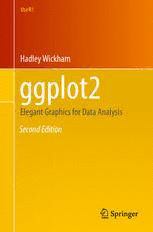
ggplot2: Elegant Graphics for Data Analysis PDF
Preview ggplot2: Elegant Graphics for Data Analysis
UseR! Hadley Wickham ggplot2 Elegant Graphics for Data Analysis Second Edition Use R! SeriesEditors: RobertGentleman KurtHornik GiovanniParmigiani Moreinformationaboutthisseriesathttp://www.springer.com/series/6991 Use R! Moore:AppliedSurvivalAnalysisUsingR Luke:AUser’sGuidetoNetworkAnalysisinR Monogan:PoliticalAnalysisUsingR Cano/M.Moguerza/PrietoCorcoba:QualityControlwithR Schwarzer/Carpenter/Ru¨cker:Meta-AnalysiswithR Gondro:PrimertoAnalysisofGenomicDataUsingR Chapman/Feit:RforMarketingResearchandAnalytics Willekens:MultistateAnalysisofLifeHistorieswithR Cortez:ModernOptimizationwithR Kolaczyk/Csa´rdi:StatisticalAnalysisofNetworkDatawithR Swenson/Nathan:FunctionalandPhylogeneticEcologyinR Nolan/TempleLang:XMLandWebTechnologiesforDataScienceswithR Nagarajan/Scutari/Le`bre:BayesianNetworksinR vandenBoogaart/Tolosana-Delgado:AnalyzingCompositionalDatawithR Bivand/Pebesma/Go´mez-Rubio:AppliedSpatialDataAnalysiswithR (2nded.2013) Eddelbuettel:SeamlessRandC++IntegrationwithRcpp Knoblauch/Maloney:ModelingPsychophysicalDatainR Lin/Shkedy/Yekutieli/Amaratunga/Bijnens:ModelingDose-ResponseMicroarray DatainEarlyDrugDevelopment ExperimentsUsingR Cano/M.Moguerza/Redchuk:SixSigmawithR Soetaert/Cash/Mazzia:SolvingDifferentialEquationsinR Hadley Wickham ggplot2 Elegant Graphics for Data Analysis Second Edition With contributions by Carson Sievert 123 HadleyWickham RStudio Houston,Texas,USA ISSN2197-5736 ISSN2197-5744 (electronic) UseR! ISBN978-3-319-24275-0 ISBN978-3-319-24277-4 (eBook) DOI10.1007/978-3-319-24277-4 LibraryofCongressControlNumber:2016937314 ©TheAuthor2016 Thisworkissubjecttocopyright.AllrightsarereservedbythePublisher,whetherthewholeorpartof thematerialisconcerned,specificallytherightsoftranslation,reprinting,reuseofillustrations,recitation, broadcasting,reproductiononmicrofilmsorinanyotherphysicalway,andtransmissionorinformation storageandretrieval,electronicadaptation,computersoftware,orbysimilarordissimilarmethodology nowknownorhereafterdeveloped. Theuseofgeneraldescriptivenames,registerednames,trademarks,servicemarks,etc.inthispublication doesnotimply,evenintheabsenceofaspecificstatement,thatsuchnamesareexemptfromtherelevant protectivelawsandregulationsandthereforefreeforgeneraluse. Thepublisher,theauthorsandtheeditorsaresafetoassumethattheadviceandinformationinthisbook arebelievedtobetrueandaccurateatthedateofpublication.Neitherthepublishernortheauthorsor theeditorsgiveawarranty,expressorimplied,withrespecttothematerialcontainedhereinorforany errorsoromissionsthatmayhavebeenmade. Printedonacid-freepaper ThisspringerimprintispublishedbySpringerNature TheregisteredcompanyisSpringerInternationalPublishingAGSwitzerland To my parents, Alison & Brian Wickham. Without them, and their unconditional love and support, none of this would have been possible. Preface Welcome to the second edition of “ggplot2: elegant graphics for data analysis”. I’m so excited to have an updated book that shows off all the latest and greatest ggplot2 features, as well as the great things that have been happening in R and in the ggplot2 community the last 5 years. The ggplot2 community is vibrant: the ggplot2 mailing list has over 7,000 members and there is a very active Stack Overflow community, with nearly 10,000 questions tagged with ggplot2. While most of my development effort is no longer going into ggplot2 (more on that below), there’s never been a better time to learn it and use it. I amtremendouslygrateful for the success ofggplot2.It’s one ofthe most commonlydownloadedRpackages(overamilliondownloadsinthelastyear!) and has influenced the design of graphics packages for other languages. Per- sonally, ggplot2 has brought me many exciting opportunities to travel the worldandmeetinterestingpeople.IlovehearinghowpeopleareusingRand ggplot2 to understand the data that they care about. A big thanks for this edition goes to CarsonSievert, who helped me mod- ernise the code, including converting the sources to R Markdown. He also updated many of the examples and helped me proofread the book. Major Changes I’ve spent a lot of effort ensuring that this edition is a true upgrade over the first. As well as updating the code everywhere to make sure it’s fully compatible with the latest version of ggplot2, I have: (cid:129) Shown much more code in the book, so it’s easier to use as a reference. Overallthebookhasamore“knitr”-ishsensibility:therearefewerfloating figuresandtablesandmoreinline code.This makesthe layouta little less pretty but keeps related items closer together. vii viii Preface (cid:129) Published the complete source online at https://github.com/hadley/ ggplot2-book. (cid:129) Switched from qplot() to ggplot() in the introduction, Chap. 2. Feedback indicated that qplot() was a crutch: it makes simple plots a little easier, but it doesn’t help with mastering the grammar. (cid:129) Added practice exercises throughout the book so you can practise new techniques immediately after learning about them. (cid:129) Addedpointerstotherichecosystemofpackagesthathavebuiltuparound ggplot2.You’llnowseeanumberofotherpackageshighlightedinthebook and get pointers to other packages I think are particularly useful. (cid:129) Overhauledthe toolboxchapter,Chap. 3, to coverall the new geoms.I’ve added a completely new section on text labels, Sect. 3.3, since it’s impor- tant and not covered in detail elsewhere. The mapping section, Sect. 3.7, has been considerably expanded to talk more about the different types of map data and where you might find them. (cid:129) Completely rewritten the scales chapter, Chap. 6, to focus on the most important tasks. It also discusses the new features that give finer control over legend appearance, Sect. 6.4, and shows off some of the new scales added to ggplot2, Sect. 6.6. (cid:129) Splitthedataanalysischapterintothreepieces:datatidying(withtidyr), Chap. 9; data manipulation (with dplyr), Chap. 10; and model visuali- sation (with broom), Chap. 11. I discuss the latest iteration of my data manipulation tools and introduce the fantastic broom package by David Robinson. The book is accompanied by a new version of ggplot2: version 2.0.0. This includes a number of minor tweaks and improvements, and considerable im- provementstothedocumentation.Comingbacktoggplot2developmentafter aconsiderablepausehashelpedmetoseemanyproblemsthatpreviouslyes- capednotice.ggplot22.0.0(finally!)containsanofficialextensionmechanism sothatotherscancontributenewggplot2componentsintheirownpackages. This is documented in a new vignette, vignette(‘‘extending-ggplot2"). The Future ggplot2isnowstableandisunlikelytochangemuchinthefuture.Therewill bebugfixesandtheremaybenewgeoms,buttherewillbenolargechangesto howggplot2works.Thenextiterationofggplot2isggvis.ggvisissignificantly moreambitiousbecauseitaimstoprovideagrammarofinteractive graphics. ggvis is still young and lacks many of the features of ggplot2 (most notably itcurrentlylacksfacettingandhasnowaytomakestaticgraphics),butover the coming years the goal is to make ggvis better than ggplot2. The syntax of ggvis is a little different to ggplot2. You won’t be able to trivially convert your ggplot2 plots to ggvis, but we think the cost is Preface ix worth it: the new syntax is considerably more consistent and will be easier for newcomers to learn. If you’ve mastered ggplot2, you’ll find your skills transferverywellto ggvisandafterstrugglingwiththe syntaxforawhile, it willstarttofeelquitenatural.Theimportantskillsyoulearnwhenmastering ggplot2 are not the programmatic details of describing a plot in code, but the much harder challenge of thinking about how to turn data into effective visualisations. Acknowledgements Many people have contributed to this book with high-level structural in- sights, spelling and grammar corrections and bug reports. I’d particularly liketothankWilliamE.J.Doane,AlexanderForrence,DevinPastoor,David Robinson and Guangchuang Yu for their detailed technical reviews of the book. Many others have contributed over the (now quite long!) lifetime of gg- plot2. I wouldlike to thank LelandWilkinson, fordiscussions andcomments that cemented my understanding of the grammar; Gabor Grothendieck, for early helpful comments; Heike Hofmann and Di Cook, for being great advi- sors and supporting the development of ggplot2 during my PhD; Charlotte Wickham; the students ofstat480and stat503atISU, for trying it outwhen itwasveryyoung;Debby Swayne,for massesofhelpful feedbackandadvice; Bob Muenchen, Reinhold Kliegl, Philipp Pagel, Richard Stahlhut, Baptiste Auguie,Jean-OlivierIrisson,ThierryOnkelinxandthemanyotherswhohave readdraftversionsofthebookandgivenmefeedback;andlast,butnotleast, the members of R-help and the ggplot2 mailing list, for providing the many interestingandchallenginggraphicsproblemsthathavehelpedmotivatethis book. Chief Scientist, RStudio Hadley Wickham Houston, TX, USA September 2015
